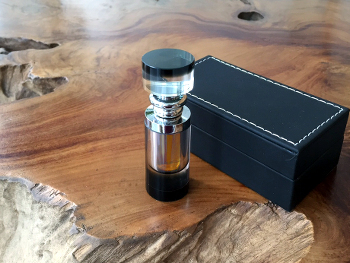- Oud Products navigate_next
- Oud Info navigate_next
- Shipping Policy
- Subscribe
- Blog
- Contact

In the entire history of Agar Aura,
this is THE best bang-for-buck oud ever distilled. Bar none.
It may be hard to believe, when you smell this oil, that Koh
Chang is the "lowest" of the three Koh Chang island
oils in the series. Even the term "low" is unbefitting; the
yield from this wood was 6ml per kilo of wood. Any distiller
with hands-on experience will tell you that an oil of this
caliber is anything but low.
Typically, this is the highest grade of wood
that gets distilled.
If you aren't already aware of Agar Aura's precise use of
terminology, quality ≠ grade. Although grade-wise Koh Chang
was a distillation of "oil-grade" wood, it
was the absolute highest quality of
oil-grade wood i.e. ancient patches of oleoresin in an
acient tree.
Its that aging of the oleoresin inside the standing
tree that makes all the difference. And the difference is
clear, the moment you smell this oil.
Swipe some on, and you are first greeted with a deep booming
woodiness. Dry, bitter, and zesty; what's amazing is that
the closest to its scent profile is neither mainstream Thai
oud, nor oud from neighboring Cambodian, but rather oud from
the east-most island of Indo-China: Hainan island.
Sweet notes of thick old-fashioned Merlot-flavored cough
syrup tame and round out the zesty woody and herbal-rooty
notes, but without flattening the scent profile. As a matter
of fact, Koh Chang is easily the richest, most complex, and
most dynamic oud oil in its price bracket.
Add to all this the fact that on top of all this, Koh Chang
is an island oud, and so it is imbued with the
same sparkly breezy 'fairy dust' that you find in oils from
other islands like Borneo and Sri Lanka.
So how different is a wild high-quality Thai oud from
readily available plantation Thai oud oils?
You'll be surprised.
“flower” just that word popped
into my head. Flower that I have never smelt before or
never will from any flower from this world. Out of this
realm stuff.
R.A. (Singapore)
The Koh Changs are shapeshifters for me. I have not
smelled anything like them until now.
M.B. (USA)
I tried Koh Chang out of curiosity since I have a bottle
coming. I can feel a buzz around my tongue, nose, ear and
general sinus area.
J.L. (USA)
My father got the bottle of Koh Chang Hazrat and he loves
it MaashaaAllah.
A.K. (USA)
Likened to Hainan. Bitter, citrus (kumquat), gently
madicinal, a little sharp, faintly (but hardly) sweet.
Borders on "green" (crushed leaves, freshly broken, moist
branches and stems) smelling without committing.
Caught wind of some not-too-sweet sugar cookies after the
opening before it went "full bitter".
Additional depth, or "body", maybe "volume" to the bright,
sharp, bitterness means satisfying richness, while still
being dry and medicinal.
A.J. (USA)
I loved Koh Chang sample.
R.A. (USA)
Sweet opening with traces of Borneo before all sweetness
disappears for a slightly tart, turmeric, spicy,
camphoric, medicinal array that approximates Chineese oud.
Some honey peaks back in for the drydown.
- Customer (USA)
Best part that I like about the Koh Chang oils is their
complexity... So many facets/notes that are all beautiful.
Z.K. (USA)
Koh Chang i find it superb compared to its price.
P.P. (India)
Just applied Koh chang , alhamdulilah very pleasant, top
notes toasted bread with saffron honey. It’s very good,
Subhanallah
- Customer (USA)
out of the 3, this is easily identifiable as Taha's
crassna. Very refined, opens up with medicinal, albeit
bitter, herbal scents. Progresses into a tea-like
sweetness. Not tart at all. Not the serious, dark tobacco
types. Like sweet, refined tea for a calming, soothing,
"zen" session, after the medicinal aspects dissipate.
Something to relax the nerves. Reminds me of oils in the
calibre of Kuzen, Kanzen, Mardelong, Au Luong, yet those
are cambodians. The only big difference, is the medicinal
herbal aspect of it, which is quite uncommon among
crassnas IMO (especially thai). Here, it's more like
pursat select.
A.S. (Malaysia)